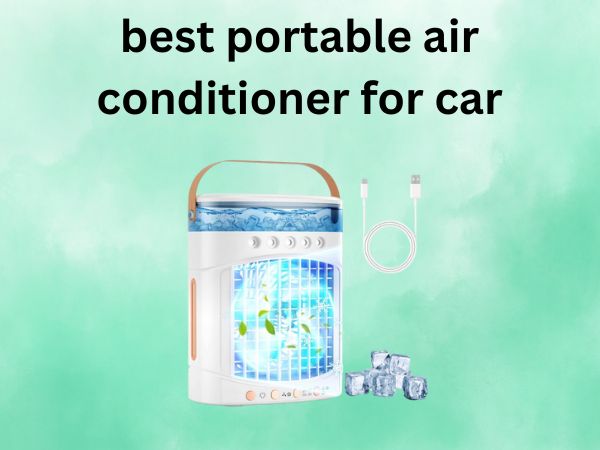5 Best Portable Air Conditioners for Car [In 2026]
Are you tired of sweating through long road trips or uncomfortable car camping adventures? You’re not alone. With rising fuel costs and the need for energy-efficient cooling solutions, portable air conditioners for cars have become increasingly popular among drivers, travelers, and outdoor enthusiasts.
Unlike traditional car AC systems that rely on your vehicle’s engine and can drain fuel efficiency, portable car air conditioners offer a smart alternative that can keep you cool without breaking the bank. Whether you’re stuck in traffic, camping in your vehicle, or simply want personal cooling while parked, these innovative devices provide targeted relief exactly where you need it.
In this comprehensive guide, we’ll explore the five best portable air conditioners specifically designed for car use, analyzing their features, benefits, and real-world performance to help you make an informed decision.
Table of Contents
Top 5 Best Portable Air Conditioners for Cars
1. Evapolar evaCHILL – Best Overall for Personal Cooling
The Evapolar evaCHILL stands out as the most refined portable air conditioner for car use, combining effective cooling with exceptional portability. This award-winning unit uses proprietary evaporative technology with a basalt fiber cartridge that not only cools air but also filters dust particles.
Key Features:
- Ultra-low 10W power consumption
- USB connectivity for versatile power options
- Four adjustable fan speeds
- Compact design with carrying handle
- 49.1 CFM airflow capacity
- One-button operation for simplicity
Performance Analysis: Real-world testing shows the evaCHILL effectively cools air by 8-10 degrees Fahrenheit within its 3-5 foot effective range. The unit requires about 20 minutes for the water to fully saturate the cartridge and reach optimal cooling performance.
The device excels in dry climates but becomes less effective when humidity exceeds 70%. For car use, this translates to excellent performance in southwestern United States regions but limited effectiveness in humid southeastern areas.
Pros and Cons
Pros:
- Extremely energy-efficient at only 10W consumption
- Works with power banks, laptops, and car outlets
- Compact and lightweight for easy storage
- Quiet operation suitable for sleeping
- Effective dust filtration capability
- Proven track record with positive user reviews
Cons:
- Limited effectiveness in humid climates
- Small water reservoir requires frequent refilling
- Takes 20 minutes to reach full cooling capacity
- Higher price point compared to basic alternatives
- Cooling limited to personal space (3-5 feet)
2. Fosvill F22 Pro – Best for Extended Use
The Fosvill F22 Pro addresses the main limitation of most portable car air conditioners: runtime. With its massive 1500ml water tank, this unit provides up to 14 hours of continuous operation, making it ideal for overnight car camping or extended travel days.
Key Features:
- 1500ml high-capacity water reservoir
- 4-in-1 functionality (cooling, humidifying, fan, lighting)
- Remote control with 16.4-foot range
- Programmable timer (1-12 hours)
- Seven-color LED ambient lighting
- Ultra-quiet operation under 25dB
Performance Analysis: The F22 Pro’s extended operational capacity makes it particularly valuable for car camping enthusiasts. The large water tank means fewer interruptions for refilling, and the timer function prevents overcooling during sleep.
The unit’s 120-degree oscillation feature helps distribute cool air more evenly throughout a small space, though it’s still most effective within close proximity to users.
Pros and Cons
Pros:
- Exceptional 14-hour runtime with large water tank
- Comprehensive remote control functionality
- Ultra-quiet operation perfect for sleeping
- Multi-color ambient lighting adds atmosphere
- Timer function prevents energy waste
- 4-in-1 functionality maximizes value
Cons:
- Larger size requires more storage space
- Higher power requirements (USB-C 5V/2A minimum)
- More complex controls may confuse some users
- Price premium for extended features
- Still limited to personal cooling range
3. Gcobup Mini AC – Best Budget Option
For budget-conscious buyers who still want reliable portable cooling, the Gcobup Mini AC offers impressive value. Despite its lower price point, this unit includes many features found in more expensive models while maintaining solid build quality.
Key Features:
- 700ml water tank for 6-8 hours operation
- Dual-speed fan settings
- Seven-color LED lighting
- Five wide-angle cooling nozzles
- USB power compatibility
- Leather carrying handle
Performance Analysis: The Gcobup unit’s five nozzles create more even airflow distribution compared to single-outlet designs. While the cooling capacity isn’t as strong as premium models, it provides adequate relief for personal cooling needs.
The 700ml tank strikes a good balance between runtime and portability, making it suitable for day trips and moderate camping use.
Pros and Cons
Pros:
- Excellent value for money
- Five nozzles provide better air distribution
- Compact and lightweight design
- Simple, intuitive controls
- USB power compatibility
- Attractive LED lighting options
Cons:
- Shorter runtime due to smaller water tank
- Less powerful cooling compared to premium models
- Basic remote control functionality
- Limited brand recognition and support
- Plastic construction feels less premium
4. NPOCLK Portable AC – Best Features
The NPOCLK model impresses with its feature-rich design, offering both panel and remote control options along with an impressive array of lighting effects. This unit represents the middle ground between basic functionality and premium performance.
Key Features:
- 1500ml large capacity water tank
- Dual spray ports for enhanced cooling
- Three wind speeds and three timer options
- Ten different colorful lighting modes
- Both touch panel and remote control
- Natural wind mode without water
Performance Analysis: The dual spray port design sets this unit apart from competitors by providing more intensive misting capability. Users can operate it in natural wind mode without water for basic air circulation, or add water for evaporative cooling.
The automatic switch to natural wind mode when water runs out prevents the unit from shutting down completely, ensuring continued air circulation.
Pros and Cons
Pros:
- Dual spray ports for enhanced cooling
- Large water tank for extended operation
- Versatile control options (panel and remote)
- Ten lighting modes for customization
- Natural wind mode provides backup cooling
- Automatic water level management
Cons:
- Higher noise level at maximum settings (55dB)
- More complex operation may overwhelm simple users
- Larger footprint requires more space
- Mixed build quality reports from users
- Limited availability and customer support
5. BLACK+DECKER Smart AC – Best for Larger Vehicles
While technically a full-size portable air conditioner rather than a personal cooling device, the BLACK+DECKER Smart AC deserves mention for RV owners, van life enthusiasts, or those with large vehicles who need serious cooling power.
Key Features:
- 12,000 BTU cooling capacity (8,000 BTU SACC)
- Smart connectivity with mobile app control
- Voice control compatibility (Alexa, Google)
- Follow Me remote with thermostat function
- Three-in-one operation (AC, dehumidifier, fan)
- Professional installation kit included
Performance Analysis: This unit operates on an entirely different level from the evaporative coolers, providing true air conditioning for spaces up to 550 square feet. However, it requires 115V AC power, meaning you need an inverter or generator for car use.
The smart features and app connectivity provide convenience unmatched by smaller units, but the power requirements limit its practical applications for standard vehicle use.
Pros and Cons
Pros:
- Genuine air conditioning performance
- Smart features and app control
- Large coverage area capability
- Proven brand reliability
- Professional cooling capacity
- Three-in-one functionality
Cons:
- Requires 115V AC power (inverter needed)
- Much larger and heavier than personal units
- High power consumption unsuitable for battery use
- Expensive compared to evaporative alternatives
- Complex installation requirements
- Overkill for personal cooling needs
Why You Need a Portable Car Air Conditioner
Benefits of Portable AC Units for Vehicles
Traditional car air conditioning systems have significant limitations that portable units can address. First, your car’s AC only works when the engine is running, which means you’re burning fuel even when parked. This becomes expensive quickly, especially during extended breaks or camping trips.
Portable car air conditioners solve this problem by operating independently of your vehicle’s engine. They can run on USB power, 12V car outlets, or even portable power banks, giving you cooling flexibility without the fuel cost. This independence is particularly valuable for people who work from their vehicles, enjoy car camping, or frequently take long breaks during travel.
Additionally, these units provide personal cooling zones rather than trying to cool your entire vehicle. This targeted approach is often more effective and energy-efficient than running your car’s AC system, especially when you’re the only occupant.
How Portable Car Air Conditioners Work
Most portable car air conditioners use evaporative cooling technology, also known as swamp cooling. This process works by passing air over water-saturated pads or filters, causing the water to evaporate and naturally cool the air. The cooled air is then blown toward you through a fan system.
This technology is particularly effective in dry climates where evaporation occurs quickly. The cooling effect can drop the temperature of the air stream by 10-15 degrees Fahrenheit, providing noticeable relief from hot weather. Some units also include humidification benefits, which can be especially welcome in arid environments.
The key advantage of evaporative cooling is its low energy consumption. These units typically use between 7-15 watts of power, compared to thousands of watts required by traditional AC systems.
What to Consider When Choosing a Portable Car AC
Power Source and Consumption
When selecting a portable car air conditioner, power requirements should be your first consideration. Most units operate on 12V DC power that can connect directly to your car’s cigarette lighter or auxiliary outlet. However, the amperage requirements vary significantly between models.
Look for units that require 2 amps or less, as higher amperage draws can strain your car’s electrical system or drain your battery when the engine isn’t running. Many modern units also offer USB connectivity, allowing you to power them from laptops, power banks, or portable charging stations.
Energy efficiency is crucial for car use since you’re working with limited power resources. Units consuming 10 watts or less are ideal for extended use without worrying about battery drain.
Cooling Capacity and Coverage Area
Understanding the cooling coverage area is essential for setting realistic expectations. Most portable car air conditioners are designed for personal cooling within a 3-5 foot radius, not for cooling entire vehicles.
The effective cooling area depends on several factors including the unit’s fan power, your local climate humidity, and the ambient temperature. In dry climates, these units perform exceptionally well, while humid environments reduce their effectiveness significantly.
Consider your specific use case: if you need cooling while driving, a smaller personal unit positioned near you will be most effective. For car camping or extended parking situations, you might prefer a unit with slightly larger coverage area.
Water Tank Size and Runtime
Water tank capacity directly affects how long your unit can operate without refilling. Smaller tanks (around 700ml) typically provide 6-8 hours of operation, while larger tanks (1500ml) can run for 12-14 hours.
For road trips and camping, larger water tanks reduce maintenance frequency and provide peace of mind during overnight use. However, larger tanks also mean heavier units and more space requirements in your vehicle.
Consider adding ice cubes to enhance cooling performance. Many users report significant temperature improvements when using ice water instead of room temperature water.
Noise Level Considerations
Noise levels become particularly important in the confined space of a vehicle. Most quality portable car air conditioners operate at 25-55 decibels, which is comparable to a quiet library or soft whisper.
For sleeping in your vehicle or maintaining conversation while the unit operates, look for models advertising under 30 decibels. Units with multiple speed settings allow you to balance cooling power with noise levels based on your immediate needs.
Detailed Comparison of Top Features
Power Consumption Analysis
Power efficiency varies dramatically across these units, directly impacting their practicality for car use. The Evapolar evaCHILL leads in efficiency at just 10 watts, making it ideal for extended battery-powered use. The Fosvill and Gcobup units consume slightly more power but remain within reasonable limits for car outlet use.
The NPOCLK model’s dual spray system requires more energy, while the BLACK+DECKER unit’s traditional AC technology demands significantly more power, requiring external power sources for car use.
For most car applications, units consuming 15 watts or less provide the best balance of cooling performance and power sustainability.
Cooling Effectiveness Comparison
Cooling effectiveness depends heavily on your environment and expectations. In dry climates (Arizona, Nevada, Colorado), evaporative coolers can provide 10-15 degree temperature drops in the immediate airflow.
The Evapolar evaCHILL offers the most consistent cooling performance, while the NPOCLK’s dual spray ports provide more intensive cooling in ideal conditions. The Fosvill unit’s oscillation feature helps distribute cooling more evenly.
Remember that these units cool the air stream, not the ambient temperature of your entire vehicle. Position yourself within the airflow for maximum benefit.
Tips for Using Portable AC in Your Car

Optimal Placement Strategies
Proper placement maximizes your portable air conditioner’s effectiveness. Position the unit 2-3 feet away from yourself with the airflow directed toward your body. Avoid placing it too close, as this can create an uncomfortable direct blast of cool air.
For car camping, place the unit on a stable surface like a center console or dashboard area where it won’t tip over during sleep. Ensure adequate clearance around air intake vents to prevent overheating.
Consider using a small fan to help circulate the cooled air throughout your vehicle’s interior, though this increases overall power consumption.
Power Management Tips
Monitor your vehicle’s battery voltage when using portable AC units with the engine off. Most car batteries can safely power low-wattage units for several hours, but extended use may prevent engine starting.
Consider investing in a portable power station for extended camping use. These battery packs can power evaporative coolers for days without depleting your car’s battery.
Use your unit’s timer function to prevent unnecessary operation during cooler nighttime hours, conserving both power and water.
Maintenance and Care
Regular maintenance ensures optimal performance and longevity. Clean or replace water filters monthly, depending on usage frequency and water quality. Use distilled water when possible to prevent mineral buildup.
Empty and dry the water tank when storing the unit to prevent mold and bacteria growth. Some units include UV sterilization features, but proper storage practices remain important.
Keep spare filters or cartridges available for units like the Evapolar that use replaceable media. These components typically last 3-6 months with regular use.
Frequently Asked Questions
Q1: Can portable car air conditioners work in humid climates? A: Evaporative coolers work best in dry climates with humidity below 70%. In humid environments like Florida or the Gulf Coast, their effectiveness decreases significantly. However, they still provide some cooling benefit and air circulation even in humid conditions.
Q2: How long can I run a portable AC unit on my car battery? A: Low-wattage units (10-15W) can typically run for 4-8 hours on a car battery without the engine running, depending on your battery’s condition and capacity. Always monitor your battery voltage and avoid depleting it below starting levels.
Q3: Do I need to use distilled water in my portable car AC? A: While not required, distilled water prevents mineral buildup and extends the life of filters and internal components. Tap water works fine for occasional use, but regular users should consider distilled water for better maintenance.
Q4: Can these units cool an entire car interior? A: No, portable evaporative coolers are designed for personal cooling within 3-5 feet of the unit. They’re not powerful enough to cool entire vehicle interiors like traditional car AC systems. Position yourself within the airflow for maximum benefit.
Q5: Are portable car air conditioners safe to use while sleeping? A: Yes, most units operate quietly and safely for overnight use. Models with timer functions and auto-shutoff features are particularly safe for sleeping. Ensure adequate ventilation and never use units that require external combustion or produce carbon monoxide.
Conclusion
Choosing the right portable air conditioner for your car depends on your specific needs, budget, and usage patterns. The Evapolar evaCHILL stands out as the best overall choice for most users, combining effective cooling with exceptional portability and energy efficiency.
For extended use and car camping, the Fosvill F22 Pro’s large water tank and quiet operation make it worth the investment. Budget-conscious buyers will find excellent value in the Gcobup Mini AC, while feature enthusiasts might prefer the NPOCLK model’s comprehensive capabilities.
Remember that these units work best in dry climates and provide personal cooling rather than whole-vehicle air conditioning. Set realistic expectations, position them properly, and maintain them regularly for optimal performance.
With the right portable air conditioner, you can stay comfortable during road trips, car camping adventures, and those inevitable traffic jams without the fuel cost and engine dependency of traditional car AC systems.




